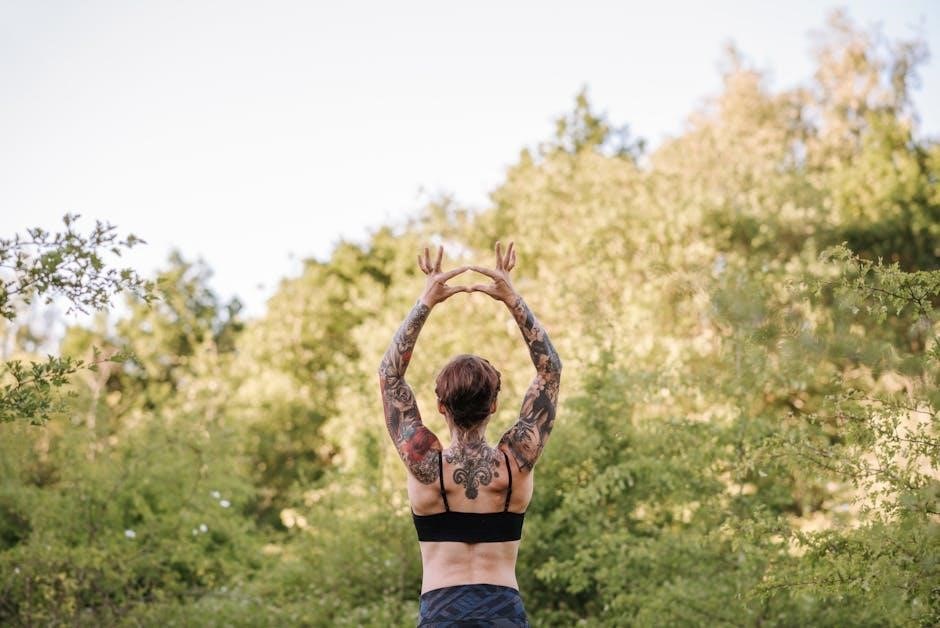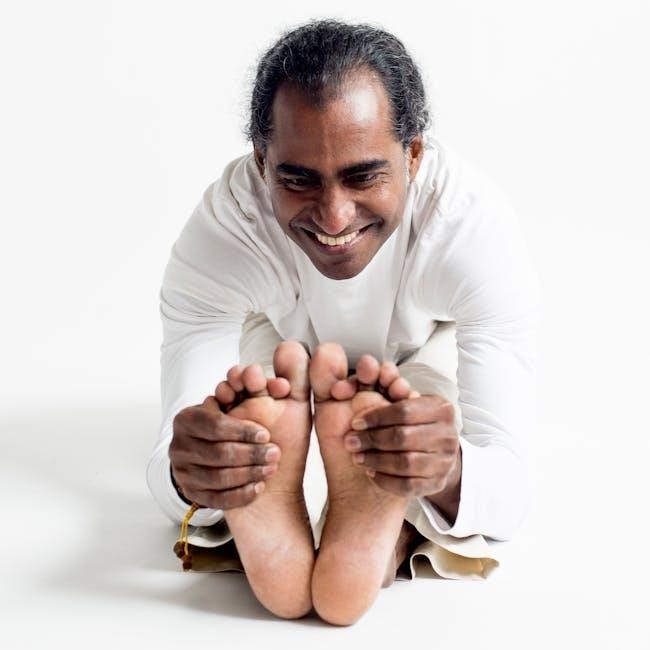Bikram Yoga is a dynamic hot yoga style comprising 26 specific postures and breathing exercises, designed to promote physical and mental well-being in a heated environment.

Structure of a Bikram Yoga Class
A Bikram Yoga class is a 90-minute session featuring 26 standardized postures and two breathing exercises, conducted in a heated, humid environment to enhance detoxification and flexibility.
Class Duration and Environment
A Bikram Yoga class typically lasts 90 minutes, conducted in a room heated to approximately 105°F (40°C) with high humidity. This intense environment is designed to mimic the climate of India, promoting detoxification through sweating and enhancing flexibility. The heat helps in loosening muscles and improving circulation, while the humidity ensures the body retains moisture. Students are encouraged to hydrate thoroughly before and during class. The challenging conditions are intended to push practitioners physically and mentally, fostering resilience and focus. Proper preparation, such as arriving early and bringing water, is essential for a safe and effective practice in this unique setting.
Sequence of Postures and Breathing Exercises
The Bikram Yoga class follows a standardized sequence of 26 postures and two breathing exercises, carefully designed to systematically work every part of the body. Each pose is held for a specific duration, typically between 30 to 60 seconds, allowing deep penetration into the muscles and maximum therapeutic benefits. The breathing exercises, Kapalabhati and Bhastrika, are incorporated to enhance lung capacity, oxygenate the body, and prepare for the physical postures. The sequence begins with standing poses to build heat and balance, followed by seated and lying postures to target flexibility, strength, and internal organs. This structured approach ensures a comprehensive and transformative practice, guiding students through a progressive flow of movements.
Overview of the 26 Postures
The 26 postures in Bikram Yoga are standardized, practiced in a heated environment, and designed to systematically work every part of the body for optimal health and transformation.
Standing Postures
Standing postures in Bikram Yoga are foundational, held for 45-60 seconds to build strength, balance, and focus. Poses like Eagle, Tree, and Toe Stand challenge equilibrium and engage core muscles. These postures improve posture, enhance flexibility, and prepare the body for more complex movements. Proper alignment is emphasized to maximize benefits and prevent injury. Breathing techniques are integrated to maintain focus and endurance. The heat intensifies the detoxifying sweat, aiding in cleansing the body. Standing postures are essential for establishing a strong practice foundation, promoting mental clarity, and setting the tone for the entire sequence. They are particularly beneficial for improving circulation and overall physical alignment.
Floor Postures
Floor postures in Bikram Yoga are designed to deepen stretches, strengthen muscles, and improve flexibility. These postures target the hamstrings, hips, and lower back, promoting relaxation and detoxification. Poses like Cobra, Bow, and Camel work the spine, enhancing its mobility and alignment. The heat amplifies the benefits, allowing for profound releases in tight areas. Floor postures also focus on breathing and mental calm, helping practitioners connect with their inner strength. They complement the standing postures by addressing different muscle groups and energy flows. Regular practice of floor postures can lead to improved circulation, reduced tension, and a stronger, more flexible body. These postures are integral to the Bikram sequence, offering a balanced and transformative experience.

Benefits of Bikram Yoga Poses
Bikram Yoga enhances physical health, mental clarity, and emotional balance through its structured sequence of postures, promoting detoxification, improved circulation, and increased flexibility in a heated environment.
Physical Benefits
Bikram Yoga offers numerous physical benefits, including improved cardiovascular health, enhanced flexibility, and strengthened muscles. The heated environment accelerates detoxification through sweating, while the structured postures promote better circulation and joint mobility. Regular practice can boost metabolism, improve posture, and increase energy levels. The sequence of poses targets all major systems, enhancing overall physical fitness and endurance. By stretching and strengthening the entire body, Bikram Yoga helps maintain optimal physical health and vitality, making it a holistic practice for long-term well-being.
Mental and Emotional Benefits
Bikram Yoga cultivates mindfulness and reduces stress by focusing on breath and movement in a challenging environment. The structured practice enhances mental discipline, fostering emotional resilience and self-awareness. The intense heat and physical exertion encourage participants to push past perceived limits, building confidence and mental strength. Regular practice can improve concentration, reduce anxiety, and promote a sense of calm and clarity. By combining physical effort with mental focus, Bikram Yoga helps practitioners develop a stronger connection between body and mind, leading to improved emotional balance and overall well-being. The practice is often described as transformative, empowering individuals to manage life’s challenges with greater ease and positivity.
Posture Correction and Circulation
Bikram Yoga improves posture by strengthening core muscles and increasing flexibility, allowing for better alignment and reduced back pain. The heat enhances circulation, promoting blood flow and detoxification. Specific poses like Cobra, Spine Twists, and Triangle target the spine and major muscle groups, helping to realign the body. Improved circulation delivers oxygen and nutrients to tissues, supporting overall health. Regular practice enhances lymphatic drainage, aiding in toxin removal. By addressing muscular imbalances and enhancing joint mobility, Bikram Yoga helps maintain proper posture and ensures efficient blood flow, contributing to long-term physical and mental well-being. These benefits make it an effective practice for improving both structural alignment and cardiovascular health.
The Role of Breathing Exercises
Breathing exercises in Bikram Yoga, like Kapalabhati and Bhastrika, enhance oxygenation, prepare the body for postures, and improve circulation, promoting detoxification and mental focus throughout practice.
Kapalabhati Breathing
Kapalabhati, or “Breath of Fire,” is a powerful breathing technique used in Bikram Yoga to energize and purify the body. It involves rapid, shallow breaths through the nose, followed by passive exhales. This practice helps stimulate digestion, detoxify the lungs, and improve circulation. Regular Kapalabhati breathing can enhance respiratory efficiency, boost energy levels, and prepare the body for the physical demands of Bikram Yoga postures. It is often performed at the beginning of a class to warm up the body and focus the mind. Kapalabhati is a cornerstone of Bikram Yoga, promoting internal cleansing and mental clarity, making it an essential component of the practice.
Bhastrika Breathing
Bhastrika, or “Bellows Breath,” is a dynamic breathing technique in Bikram Yoga that involves rapid, forceful inhalations and exhalations through the nose. This energizing practice mimics the action of a bellows, pumping air in and out of the lungs to increase oxygen flow and internal heat. Bhastrika is often performed at the beginning of a class to prepare the body for the intense postures ahead. It helps to awaken the nervous system, boost energy levels, and purify the body by expelling stale air. Regular practice of Bhastrika can improve respiratory function and mental focus. While it is beneficial, beginners should practice cautiously to avoid overexertion and ensure proper technique.

Modifications and Variations
Modifications allow practitioners to adapt poses to their fitness level, ensuring safety and accessibility. Variations help customize the practice, catering to individual needs and preventing injuries while promoting progress.
Importance for Beginners
Bikram Yoga is highly accessible for beginners, offering a structured approach to learning the 26 poses. The sequential practice ensures a gradual progression, allowing new practitioners to build strength and flexibility safely. The heated environment helps improve circulation and flexibility while detoxifying the body through sweat. Proper hydration and preparation are emphasized to support the challenging conditions. Modifications are encouraged to accommodate individual fitness levels, making the practice inclusive for all. The focus on posture correction and alignment helps beginners develop good habits from the start. Regular practice enhances mental discipline and focus, providing a holistic foundation for overall well-being. Bikram Yoga is an excellent choice for those seeking a transformative and structured yoga experience.

Hydration and Preparation
Proper hydration is crucial before, during, and after class. Drink water generously, bring a towel and mat, and eat a light meal 1-2 hours prior for optimal preparation.
Preparation Tips
Proper preparation ensures a safe and effective Bikram Yoga practice. Arrive hydrated by drinking plenty of water beforehand. Eat a light meal 1-2 hours before class to maintain energy levels without discomfort. Bring a yoga mat, towel, and water bottle to manage sweat and stay hydrated. Avoid heavy makeup or jewelry that may interfere. Familiarize yourself with the 26 poses using a Bikram Yoga Poses PDF guide to understand proper alignment and breathing techniques. Arrive early to acclimate to the heated environment and mentally prepare for the challenging sequence ahead. Listening to your body and modifying postures as needed is key to a successful practice.
Safety Precautions
Stay hydrated before, during, and after class. Listen to your body to avoid overexertion. Consult a healthcare provider if you have medical conditions. Practice proper breathing techniques to manage heat and stress. Use a high-quality yoga mat for grip and stability in sweaty conditions.
Listening to Your Body
Listening to your body is crucial in Bikram Yoga. Honor physical limits to avoid injury. Rest when needed and modify postures as necessary. Focus on breath awareness to maintain balance and prevent overexertion. Hydrate adequately and avoid pushing through pain. Recognize that each practice is unique, and it’s okay to take breaks. Instructors encourage students to respect their bodies’ signals, ensuring a safe and transformative experience. This mindful approach fosters self-awareness and promotes long-term well-being. By tuning into your body’s needs, you can fully embrace the benefits of Bikram Yoga while maintaining a healthy and sustainable practice. This ensures progress without compromising safety or comfort.

The Bikram Yoga Poses PDF Guide
The Bikram Yoga Poses PDF Guide offers a comprehensive breakdown of the 26 asanas, detailing their purposes, benefits, and step-by-step instructions for proper alignment and execution.
Content and Design
The Bikram Yoga Poses PDF Guide is meticulously designed to enhance learning and practice. It features detailed descriptions of each of the 26 postures, including their Sanskrit names, purposes, and benefits. The guide incorporates step-by-step instructions, visual cues, and modifications to cater to different fitness levels. High-quality images and diagrams illustrate proper alignment, making it easier for practitioners to understand and execute the poses correctly. The layout is user-friendly, with clear sections and headings that allow for quick navigation. Whether you’re a beginner or an experienced practitioner, this guide serves as an invaluable resource, providing a comprehensive and accessible approach to mastering Bikram Yoga.
Role in Practice
The Bikram Yoga Poses PDF Guide plays a vital role in practice by providing a structured reference for mastering the sequence of 26 postures. It offers step-by-step instructions, ensuring proper alignment and execution of each pose. Practitioners rely on it to follow the sequence accurately, understand modifications, and track progress. Instructors often use the guide to maintain consistency in teaching, while students appreciate its clarity and accessibility. Regular use of the guide enhances understanding of the poses, breathing techniques, and overall practice. It serves as an essential tool for anyone aiming to deepen their Bikram Yoga practice and achieve its full benefits effectively.
Digital Resources for Bikram Yoga
Digital resources like the Bikram Yoga Poses PDF offer a comprehensive guide to the 26 postures. Online tutorials and mobile apps provide accessible learning tools for all levels.
Online Tutorials
Online tutorials are an excellent way to master the 26 Bikram Yoga postures and breathing exercises. These tutorials often include video demonstrations, step-by-step instructions, and interactive guides. Many platforms offer tutorials designed for both beginners and advanced practitioners, providing modifications and tips for proper alignment. They are particularly useful for those who prefer self-paced learning or cannot attend in-person classes. The tutorials frequently complement the Bikram Yoga Poses PDF, offering visual aids to enhance understanding. By leveraging these digital tools, practitioners can deepen their practice and achieve the full benefits of Bikram Yoga from the comfort of their homes or while traveling.
Mobile Apps
Mobile apps dedicated to Bikram Yoga provide convenient access to the 26 poses and breathing exercises, allowing practitioners to practice anytime, anywhere. These apps often feature detailed instructions, pose tracking, and customizable practice plans. Many include timers to help users maintain proper posture durations, as well as progress tracking to monitor improvement. Some apps offer video tutorials and alignment tips, while others focus on guiding beginners through the sequence. Popular apps like Bikram Yoga Pose Guide or Hot Yoga Tracker are excellent resources for those seeking to deepen their practice. They complement the Bikram Yoga Poses PDF by offering interactive and portable learning tools, ensuring consistency and growth in one’s yoga journey.
Online Communities
Online communities dedicated to Bikram Yoga serve as vibrant hubs for practitioners to connect, share experiences, and access resources like the Bikram Yoga Poses PDF. These platforms, such as Facebook groups, Reddit forums, and specialized yoga websites, foster a sense of belonging and support. Members often discuss tips for mastering the 26 postures, share modifications, and exchange advice for improving practice. Many communities also host live sessions, Q&A threads with instructors, and challenges to keep participants motivated. These spaces are invaluable for both beginners and advanced practitioners, offering a wealth of knowledge and inspiration to enhance their Bikram Yoga journey. They also provide a space to ask questions and learn from others, ensuring continuous growth and understanding of the practice.
Getting Started with Bikram Yoga
Starting Bikram Yoga begins with proper hydration, wearing lightweight clothing, and bringing a mat or towel. Arrive early, be open-minded, and fully commit to the practice.
Tips for Beginners
For newcomers to Bikram Yoga, it’s essential to arrive well-hydrated and wear lightweight, breathable clothing. Bring a yoga mat or towel to ensure grip and comfort in the heated environment. Arrive 15-20 minutes early to acclimate to the temperature and set up your space. Begin slowly, listening to your body and modifying poses as needed. Focus on proper alignment and breathing techniques rather than pushing too hard. Use props or rest when necessary, and stay present throughout the practice. Consistency is key, so commit to regular classes to experience progressive benefits. Finally, consult your instructor for personalized guidance and use a Bikram Yoga PDF guide to prepare and enhance your practice.

The Role of Instructors
Bikram Yoga instructors guide students through the 26 postures, ensuring proper alignment, offering modifications, and fostering a supportive environment to help students achieve their full potential.
Qualifications and Experience
Bikram Yoga instructors undergo rigorous training, typically completing a 9-week, 500-hour teacher training program accredited by Bikram Choudhury. They master the 26-pose sequence, teaching techniques, anatomy, and modifications. Experienced instructors often have years of practice, refining their ability to guide students safely and effectively. Many start as assistants, gaining hands-on experience and feedback. Continuous education through workshops ensures they stay updated on best practices. Their expertise helps students navigate the challenging poses, especially in the heated environment, fostering a safe and transformative practice for all levels. Proper qualifications ensure instructors can address individual needs, making them integral to the Bikram Yoga experience.

Popularity and Global Reach
Bikram Yoga has gained worldwide popularity, with its 26-pose sequence practiced globally. Its standardized approach appeals to diverse cultures, making it a prominent style in yoga communities everywhere.
Cultural Impact
Bikram Yoga has had a significant cultural impact, popularizing hot yoga worldwide. Its structured 26-pose sequence, practiced in heated rooms, has influenced modern yoga practices globally. The availability of Bikram Yoga poses PDF guides has made it accessible to diverse cultures, fostering a sense of community among practitioners. While it has been criticized for its intensity and controversies surrounding its founder, Bikram Yoga remains a prominent style, blending traditional techniques with modern adaptations. Its global reach has inspired various interpretations, making it a cultural phenomenon in the yoga world.

Scientific Studies and Research
Scientific studies highlight Bikram Yoga’s benefits, including improved flexibility and cardiovascular health. Researchers suggest shorter sessions and lower temperatures for safer practice.
Supporting Benefits
Scientific studies validate the effectiveness of Bikram Yoga, highlighting its ability to improve cardiovascular health, enhance muscle flexibility, and promote detoxification through sweating. Research indicates that regular practice can lower blood pressure, improve circulation, and strengthen the immune system. The structured sequence of postures is designed to target specific organs and systems, fostering overall well-being. Studies also suggest that the heat component accelerates fat loss and muscle toning. Additionally, the practice has been shown to reduce stress and improve mental clarity, making it a holistic approach to health. These findings reinforce the transformative potential of Bikram Yoga for both physical and mental health.

Comparison with Other Yoga Styles
Bikram Yoga differs through its fixed 26-pose sequence in a heated environment, contrasted with Vinyasa Flow’s dynamic movements or Hatha Yoga’s broader focus, emphasizing detoxification and structure.
Unique Aspects
Bikram Yoga’s uniqueness lies in its standardized sequence of 26 postures and two breathing exercises conducted in a heated room. This fixed structure ensures consistency across sessions, targeting specific health benefits. Unlike other styles, the heat enhances detoxification through sweating, while the rigid sequence aids in progressive muscle engagement. The practice is designed to be accessible yet challenging, making it suitable for all levels. The combination of heat, precise postures, and breathing techniques distinguishes Bikram Yoga as a holistic practice aimed at physical, mental, and emotional transformation, fostering discipline and focus in a controlled environment.
Bikram Yoga offers a transformative practice through its structured 26-posture sequence, performed in a heated environment. This method promotes physical strength, flexibility, and mental clarity while fostering detoxification and discipline. Ideal for all levels, it provides a comprehensive workout that enhances overall well-being. The Bikram Yoga PDF guide serves as an essential resource, detailing each pose’s benefits and proper execution. Emphasizing consistency and focus, this practice encourages a holistic approach to health, making it a valuable addition to any wellness routine. By following the guide, practitioners can maximize their experience and achieve lasting benefits from this unique and challenging yoga style.